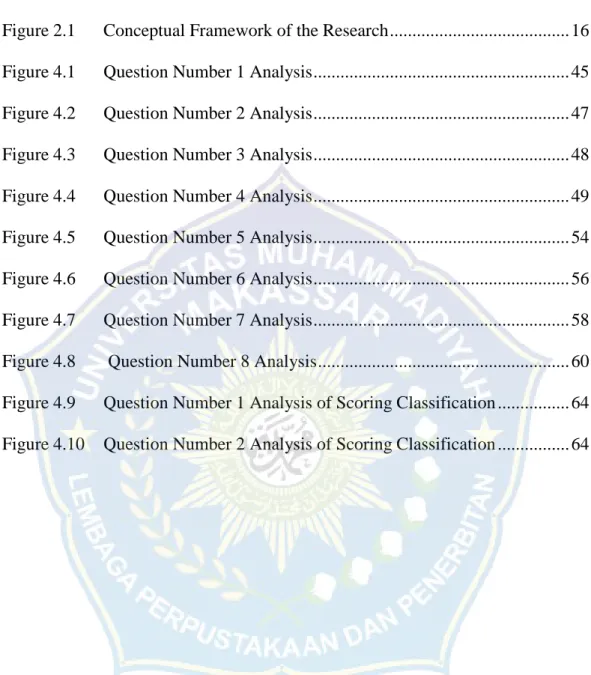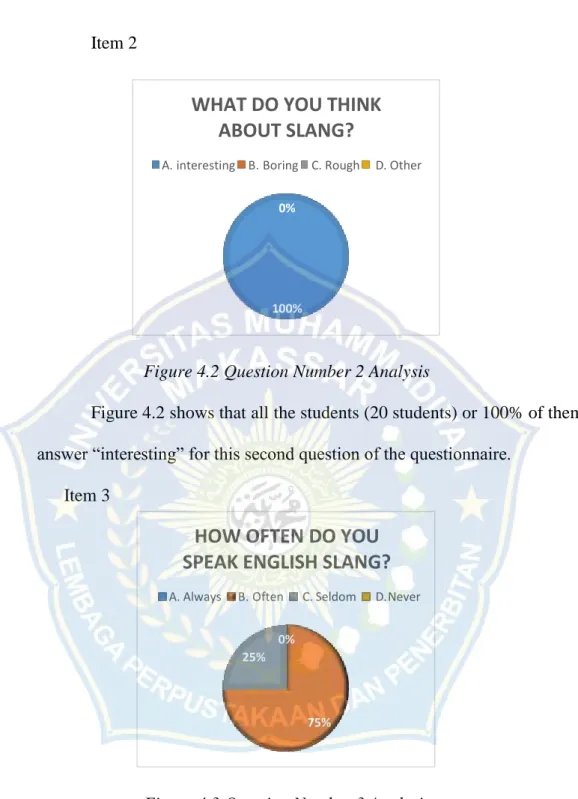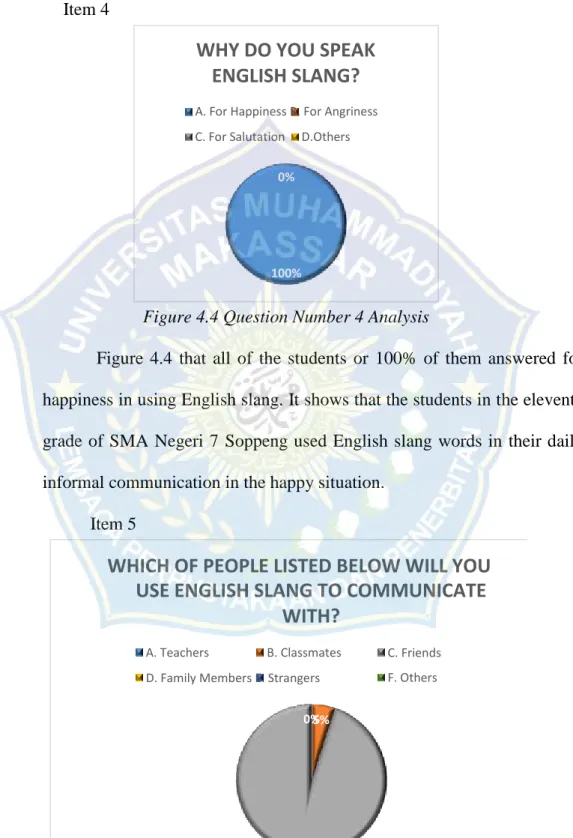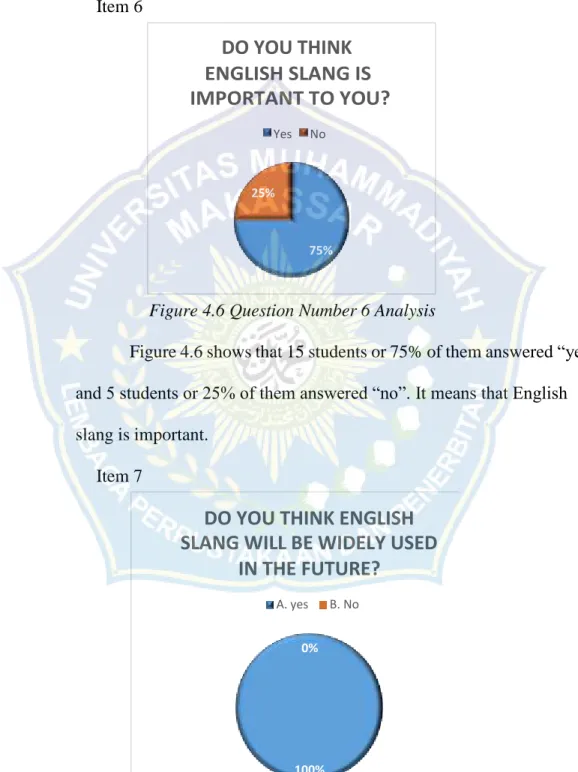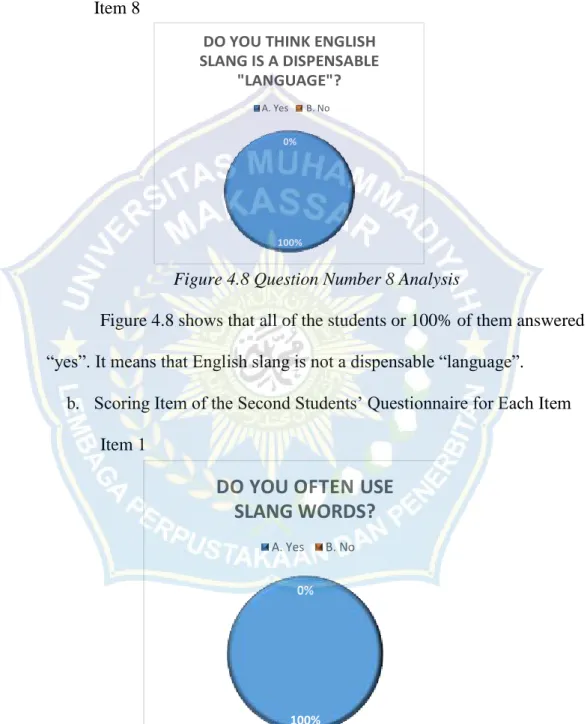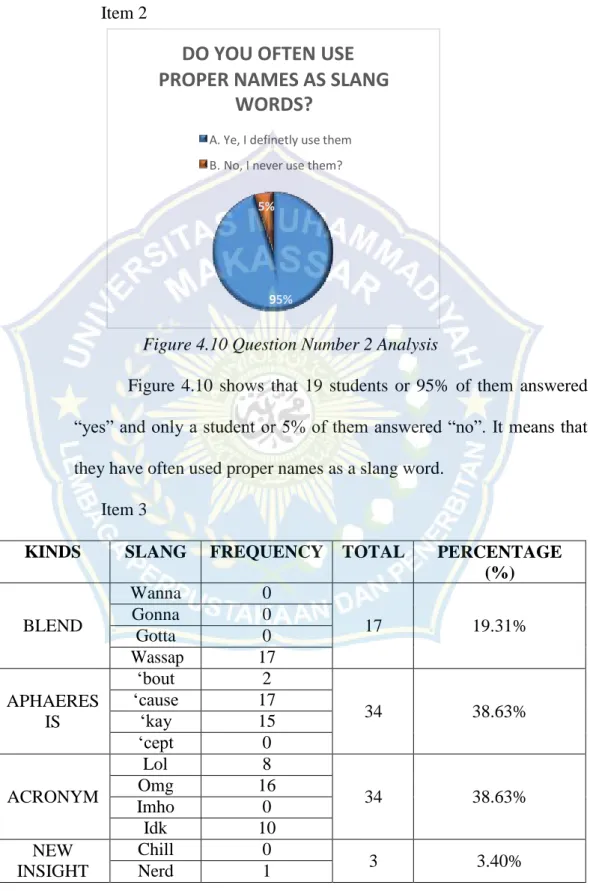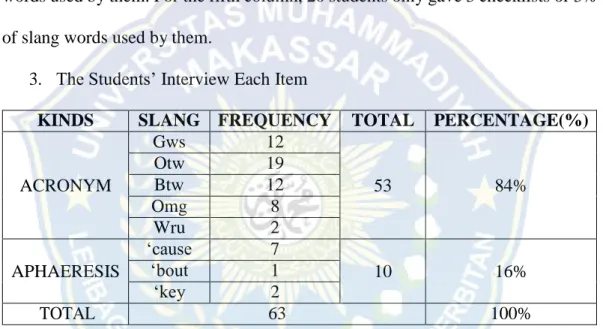Submitted to Faculty of Teacher Training and Education Makassar Muhammadiyah University in partial fulfillment. The objectives of the research were to determine the types of slang used by students, the reasons why students use slang words and the frequency of students' use of slang. The findings of the research showed that: (1) the students knew and used slang words belonging to the acronym.
Then 15% used apheresis and the remaining 3% use new insight into the already existing word; (2) most of them answered for happiness using English slang; (3) and it showed that they often used English slang words in their daily informal communication. Ummi Khaerati Syam, S.Pd., M.Pd., the head of the English Education Department of FKIP Unismuh Makassar, who gave me valuable authorities and suggestions for doing thesis. Arief Muhsin, S.Pd., M.Pd., as the other consultant who had given their valuable time and patient for guidance and support to complete this thesis.
The staff and all teachers of the FKIP Unismuh Makassar, especially the teachers of the English department who taught her for many years. Muslam, the director of SMAN 1 Lilirilau Kabupaten Soppeng and Herlina S.Pd., M.Pd., the English teacher and all the students who had become her object in conducting research in academic year 2017. Finally Alhamdulillahi Robbil Alamin and she wants I would like to thank everyone who has been important for the successful realization of this thesis.
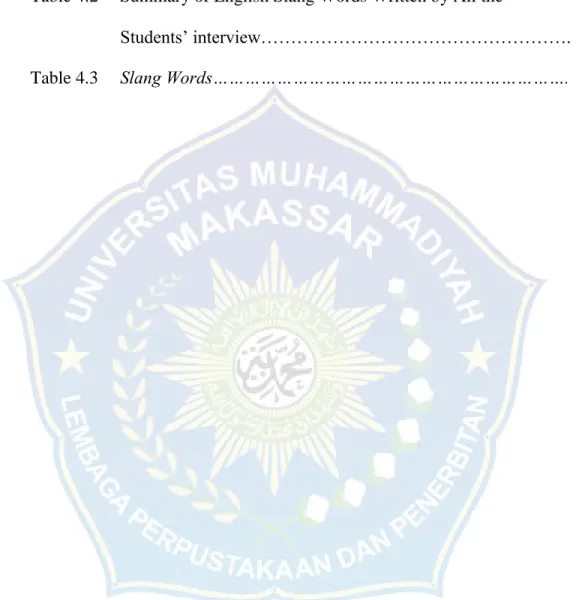
INTRODUCTION
- Problem Statement
- Objective of the Research
- Significance of the Research
- Scope of the Research
Therefore, he does not know that he cannot use it in a formal situation such as in the learning process. Based on the previous explanation above, the researcher investigated the students' slang knowledge and the students' reason for using the slang words. Therefore, the students are able to apply their knowledge about slang in the appropriate daily communication, especially in the informal situation.
What kind of slang language is used in eleventh grade students of SMA Negeri 7 Soppeng. Basically, the significance of this research was to increase the study about the use of slang and the understanding of the types of slang language used in eleventh grade students in SMA Negeri 7 Soppeng. Furthermore, in this research students applied their knowledge and understanding in appropriate everyday communication, especially in informal situations.
The researcher focused on the types of slang use by students, the reasons for using slang words by students, and the frequency of slang use by students.
REVIEW OF RELATED LITERATURE
Some Pertinent Idea
Thornbury in Singh says that pronunciation refers to the student's ability to produce comprehensible utterances to meet the demands of the task. Brown in Singh says that grammar is the system of rules that govern the arrangement and conventional relations of words in a sentence. Wardhaugh in Rosa says that linguistic variation is a way of characterizing in certain variations is to say that speakers of a particular language sometimes speak in the different dialect of that language.
In Sau-ling, Finegan says the slang is particularly popular among teenagers and students in general. In Daliman, Adams says that a speaker uses slang to achieve social dynamics with the people he is speaking to, slang outlines social spaces, and attitudes toward slang help identify and construct social groups and identity. Based on the above explanation, it can be concluded that slang is used in an informal environment, especially among the young generation or teenagers.
Based on the previous explanation above, we can conclude that there are four main characteristics of slang as mentioned by Battistella. Khan and Illson in Salma (2013: 2) say that types of slang are a mixture, an acronym, a new insight into an already existing word and apheresis. Ellis in Sari says that slang is a type of language used in certain contexts, with the meaning of which people express their sense of belonging to a certain group within a community that is not specific to any geographical location.
In Jimmy, Dooly says that mostly young people use slang, generally because it's cool. Ober in Jimmy says that the use of slang in everyday speech presents no problems; contains accurate information and can be specified. In Jimmy, Matiello says that while slang generally creates a sense of intimacy among group members, it can also create a sense of exclusion or even rejection among people outside the group.
Hybels and Weaver in Muhartoyo and Wijaya say that communication is a process between people to share information, ideas and feelings. Rizvi in Muhartoyo and Wijaya says there are two ways to have a communicative conversation: formal and informal.
Conceptual Framework
The conceptual framework for this research consists of some main points which are interconnected, which is shown in Figure 2.1.
RESEARCH METHOD
- Object of the Research
- Instrument of the Research
- Procedure of Collecting Data
- Technique of Data Analysis
Observation is necessary to gather data such as slang words used in students' daily communication. It shows that the eleventh grade students in SMA Negeri 7 Soppeng used English slang words in their daily informal communication in the happy situation. Thus, the researcher assumes that students use this slang to express their shocked feeling.
All students or 100% of them answer Interesting to this second question in the questionnaire. The figure shows that all the students or 100% of them answered for happiness using English slang. It shows that eleventh grade students in SMA Negeri 7 Soppeng used English slang words in their daily informal communication when they were happy.
The result shows that all the students give the reason for using English slang words to express happiness. The majority of students indicate that their friends are their interlocutors when they use English slang. The third question of the questionnaire was designed to find out what kind of English slang words the students used.
Analysis of the students' interview Each point (See Appendix V) Based on the data analysis result, it shows that 14 slang words were found among teenagers in their communication. Furthermore, aphaeresis is the second most common type of English slang written and spoken by students. Thus, all the students or 100% of them answered for happiness using English slang.
It is supported by all students and 100% of them responded to commonly used slang words. Do you know what English slang is? if your answer is “NO”, the questionnaire is over).
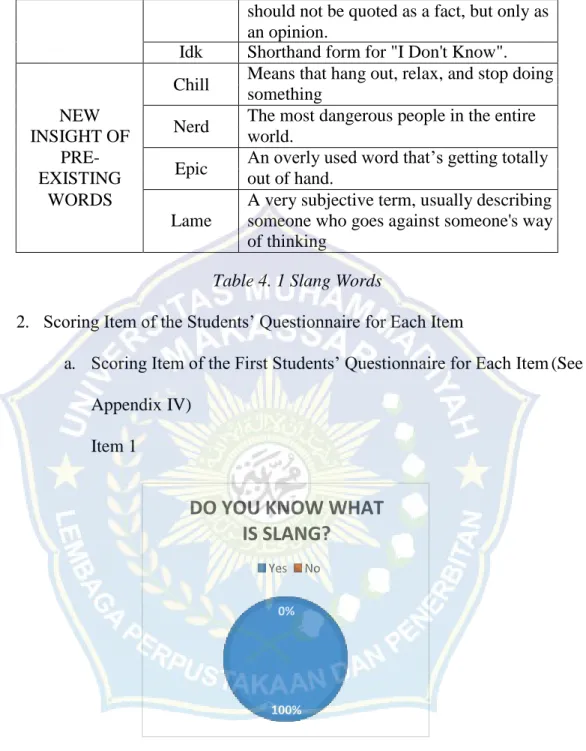
FINDINGS AND DISCUSSION
Discussion
The researcher assumes that students use this slang to express their agreement in a cool and easy way. Researchers hypothesize that students use "lol" to express their amusement when they communicate on a daily basis. The researcher thus assumes that the students used this slang because they wanted to confuse someone else.
The word "lame" that is said by the students when they argue with each other in their certain group. This is supported by the theory proposed by Pradianti, saying that in accordance with the reasons why the students use slang words, slang can show the group membership. Inquiring this fact will help the researcher to get the idea that slang words are not something that the students avoid using.
It is not surprising if almost all students respond to friends as the people they communicate with often using English slang. The results of the interview also show that students tend to be more aware of the use of jargon. So, eight questions answered the formulation of the first problem that the slang word most often used by students is an acronym.
Appendix II, specifically in number 4, answered the second problem statement that the reason why the students use Slang in their daily activities is happiness. Appendix III answered the last problem statement that how often the students use jargon in their daily communication, all students or 100% of them often answered. Looking at the jargon use of the students from the questionnaire and the interview, the researcher concluded that most of the students of SMA Negeri 7 Soppeng used jargon in their daily communication.
The types of slang used by the students in the eleventh grade students of SMA Negeri 7 Soppeng are mixture, apheresis, acronym and new insight into already existing words. This research only talks about the type of slang, it focuses on the reasons for using slang, the frequency of students to use slang in everyday communication.
CONCLUSION AND SUGGESTION
Suggestion
In addition, another research can be done using other types of slang words and using more respondents (larger population). Language of Communication among University Students in Nigeria: A Study of Slang Expressions in the Federal University of Technology Owerri. Online), (http://docplayer.net/46472523-Slang-expressions-analysis-in-grown-ups- 2-movie-jimmi-bahasa-inggris-aba-bsi-jakarta-jl-salemba-tengah-no- 45- jakarta-pusat.html, Accessed 29 May 2017).
Study on Vocabulary Learning Strategy Used by Eighth Semester Students of English Department of IAIN Tulungagung in Academic Year 2013-2014. The use of English slang words in informal communication among 8th semester students in the English department at Binus University. The use of slang words among junior high school students in everyday conversations (a case study in ninth grade students of a junior high school in Bandung).
Strategi Subtitle Ekspresi Slang Bahasa Inggris di Subtitle Serial TV Indonesia: Hannah Montana Season 4. Lol - Singkatan dari Laugh out loud (tertawa keras) Omg - Singkatan dari Ya Tuhan (oh my god). 5 Dengan kelompok orang manakah di bawah ini Anda biasanya menggunakan bahasa gaul bahasa Inggris saat berkomunikasi?
